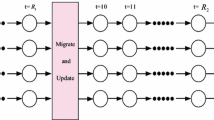Abstract
In this paper, a new heuristic called bat intelligence (BI) is introduced for solving energy aware multiprocessor scheduling problems. Bat intelligence is a novel optimization method that models prey hunting behaviors of bats. Bat intelligence and genetic algorithm (GA) are used to solve single-objective multiprocessor scheduling problem using, makespan, tardiness, and energy consumption as objective functions. Bat intelligence shows considerable improvement in terms of solution quality when compared with GA. Different combinations of these objectives are used to solve bi-objective multiprocessor scheduling problems, (makespan vs. energy, and also tardiness vs. energy). Tri-objective multiprocessor scheduling problem is also presented at the end. To generate desirable efficient alternatives, a Normalized Weighted Additive Utility Function is used. Simulation shows that BI identifies a set of efficient solutions that correspond to the assigned weights. The computational simulation also shows conflicting relationships between makespan and energy, and also between tardiness and energy.
Similar content being viewed by others
References
Ahmad I., Dhodhi M. (1996) Multiprocessor scheduling in a genetic paradigm. Parallel Computing 22: 395–406
Andrei A., Shmitz M., Eles P., Peng Z., Al-Hashimi B. (2005) Overhead-conscious voltage selection for dynamic and leakage energy reduction of time-constrained systems. IEEE Proceedings—Computers and Digital Techniques 152(1): 28–38
Berrichi A., Amodeo L., Yalaoui F., Châtelet E., Mezghiche M. (2009) Bi-objective optimization algorithms for joint production and maintenance scheduling: application to the parallel machine problem. Journal of Intelligent Manufacturing 20(4): 389–400
Bhunia S., Datta A., Banerjee N. (2005) GAARP: A power-aware GALS architecture for real-time algorithm-specific tasks. IEEE Transaction on Computers 54(6): 754–761
Bunde D. P. (2009) Power-aware scheduling for makespan and flow. Journal of Scheduling 12(5): 489–500
Garey M. R., Johnson D. S. (1975) Complexity results for multiprocessor scheduling under resource constraints. SIAM Journal on Computing 4(4): 397–411
Ghose K., Horiuchi T., Krishnaprasad P. S., Moss C. (2004) Echolocating bats use a nearly time-optimal strategy to intercept prey. Plos Biology 4(5): 865–873
Goh L., Veeravalli B., Viswanathan S. (2009) Design of fast and efficient energy-aware gradient-based scheduling algorithms for heterogeneous embedded multiprocessor system. IEEE Transaction on Parallel and Distributed Systems 20(1): 1–12
Gorjiara, B., Chou, P., Bagherzadeh, N., Reshadi, M., & Jensen, D. (2004). Fast and efficient voltage scheduling by evoluationary slack distribution. In Proceeding of Asia and South Pacific design automation conference (ASP-DAC ’04) (pp. 659–662).
Gorjiara, B., & Bagherzadeh, N. (2007). Ultra-fast and efficient algorithm for energy optimization by gradient-based stochastic voltage and task scheduling. ACM Transactions of Design Automation of Electronic Systems, 12(4), 39:7–39:13.
Gruian, F., & Kuchcinski, K. (2001). LEneS: Task scheduling for low-energy systems using variable supply voltage processors. Proceedings of the 2001 conference on Asia South Pacific design automation (pp. 449–455.
Jiong L., Jha N.K. (2007) Power-efficient scheduling for heterogeneous distributed real-time embedded systems. IEEE Transactions on Computer-Aided Design of Integrated Circuits and Systems 26(6): 1162–1167
Kalko E. K. V. (1995) Insect pursuit, prey capture and echolocation in pipistrelle bats. Animal Behavior 50: 861–880
Kang J., Ranka S. (2010) Dynamic slack allocation algorithms for energy minimization on parallel machines. Journal of Parallel and Distributed Computing 70(5): 417–430
Li, X., Yalaoui, F., Amodeo, L., & Chehade, H. (2010). Metaheuristics and exact methods to solve a multiobjective parallel machines scheduling problem. Journal of Intelligent Manufacturing. doi:10.1007/s10845-010-0428.
Luo J., Jha N.K. (2007) Power-efficient scheduling for heterogeneous distributed real-time embedded systems. Computer-Aided Design of Integrated Circuits and Systems, IEEE Transactions on 26(6): 1161–1170
Malakooti B. (2009) Systematic decision process for intelligent decision making. Journal of Intelligent Manufacturing 22(4): 627–642
Malakooti B. (2000) Ranking and screening multiple criteria alternatives with partial information and use of ordinal and cardinal strength of preferences. IEEE Transactions on Systems, Man, and Cybernetics, Part A 30(3): 355–369
Malakooti B. (2010) Independent, convergent, and divergent decision behavior for interactive multiple objectives linear programming. Engineering Optimization 42: 325–3464
Merritt J. F. (2010) The biology of small mammals. John Hopkins University Press, USA
Neuweiler G. (1989) Foraging ecology and audition in echolocating bats. Trends Ecol. Evol 4: 160–166
Pinedo M. (2008) Scheduling: theory, algorithms, and systems (3rd ed.) Springer, Berlin
Rong P., Pedram M. (2008) Energy-aware task scheduling and dynamic voltage scaling in a real-time system. Journal of Low Power Electronics, 4 10(1): 1–10
Salehi M., Bahreininejad A. (2010) Optimization process planning using hybrid genetic algorithm and intelligent search for job shop machining. Journal of Intelligent Manufacturing 22(4): 643–652
Schmitz, M. T., Al-Hashimi, B. M., Eles, P. (2002). Energy-efficient mapping and scheduling for DVS enabled distributed embedded systems. IEEE Proceedings of Design, Automation and Test in Europe Conference and Exhibition (DATE.02), 514–521.
Suh N. P. (2005) Complexity: theory and applications. Oxford University Press, Oxford
Xing L.-N., Chen Y.-W., Yang K.-W. (2009) An efficient search method for multi-objective flexible job shop scheduling problems. Journal of Intelligent Manufacturing 20(3): 283–293
Zhang, Y., Hu, X., & Chen, D. (2002). Task scheduling and voltage selection for energy minimization. In proceedings of the 39th conference on design automation New Orleans, Louisiana, USA, June 10–14.
Zhang, Y., Hu, X., & Chen, D. Z. (2003). Energy minimization of real-time tasks on variable voltage processors with transition energy overhead. In Proceedings of ASP-DAC0 (pp. 65–70). New York: ACM Press.
Author information
Authors and Affiliations
Corresponding author
Rights and permissions
About this article
Cite this article
Malakooti, B., Sheikh, S., Al-Najjar, C. et al. Multi-objective energy aware multiprocessor scheduling using bat intelligence. J Intell Manuf 24, 805–819 (2013). https://doi.org/10.1007/s10845-012-0629-6
Received:
Accepted:
Published:
Issue Date:
DOI: https://doi.org/10.1007/s10845-012-0629-6




